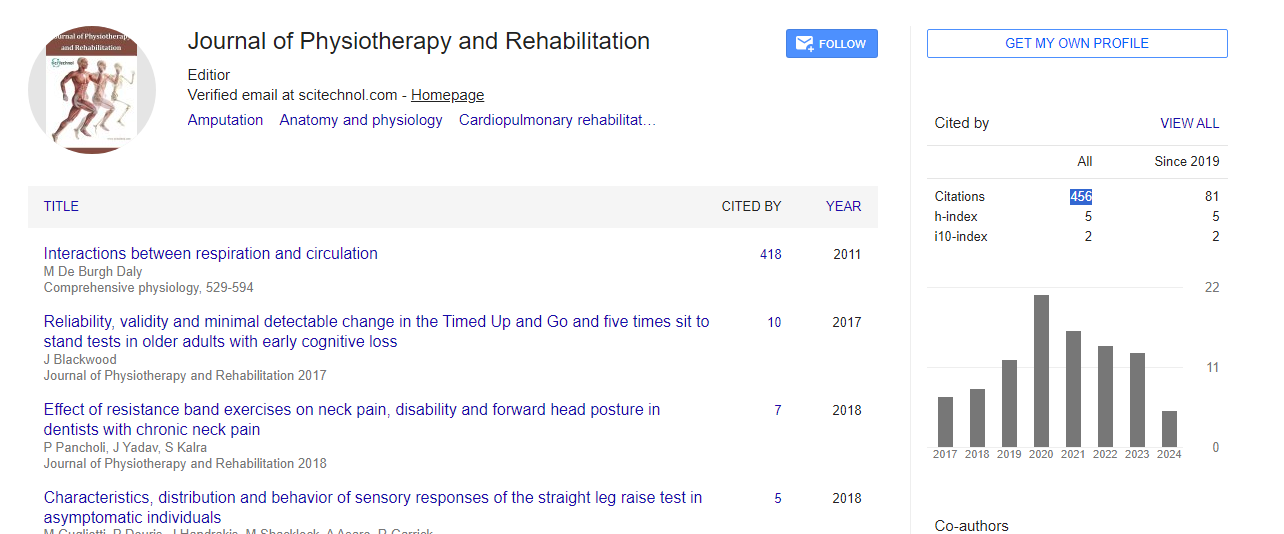Perspective, J Physiother Rehabi Vol: 8 Issue: 4
Long-Term Outcomes in Cerebral Palsy: Evaluating the Efficacy of Various Interventions and Their Impact on Life Quality
Comin Lah*
1Department of Orthopaedic Surgery, Far Eastern Memorial Hospital, New Taipei City, Taiwan
*Corresponding Author: Comin Lah,
Department of Orthopaedic Surgery, Far
Eastern Memorial Hospital, New Taipei City, Taiwan
E-mail: laho@comin126.cn
Received date: 23 July, 2024, Manuscript No. JPTR-24-147320
Editor assigned date: 25 July, 2024, PreQC No. JPTR-24-147320 (PQ);
Reviewed date: 08 August, 2024, QC No. JPTR-24-147320
Revised date: 15 August, 2024, Manuscript No. JPTR-24-147320 (R);
Published date: 22 August 2024, DOI: 10.4172/JPTR.1000176.
Citation: Lah C (2024) Long-Term Outcomes in Cerebral Palsy: Evaluating the Efficacy of Various Interventions and Their Impact on Life Quality. J Physiother Rehabi 8:4.
Description
Cerebral Palsy (CP) is a group of permanent movement disorders that appear in early childhood and affect motor skills and coordination. The severity and impact of CP can vary widely, necessitating a range of interventions to improve outcomes. As individuals with CP grow older, evaluating the long-term outcomes of these interventions becomes important for understanding their effectiveness and enhancing life quality. Cerebral palsy is caused by damage to the developing brain typically occurring before or during birth. It can result in a variety of motor impairments including spasticity, dystonia and ataxia. Which affect movement and posture. Additionally, individuals with CP may experience intellectual disabilities, speech and language difficulties and sensory impairments.
Physical Therapy (PT) is a foundation of CP management, focusing on improving motor skills, strength and coordination. Long-term studies have shown that early and ongoing PT can significantly enhance mobility, reduce spasticity and improve overall physical function. Therapists use a variety of techniques including stretching exercises, strengthening routines and gait training to support functional development. Evidence suggests that individuals who engage in regular PT throughout their lives often achieve better longterm outcomes in terms of mobility and independence.
Occupational Therapy (OT) aims to improve daily living skills and fine motor abilities. Long-term OT interventions can help individuals with CP develop the skills necessary for self-care, school activities and eventually employment. Techniques such as adaptive equipment training and sensory integration therapy are commonly used. Research indicates that ongoing OT can enhance quality of life by promoting greater independence and participation in everyday activities.
Speech and language therapy addresses communication difficulties and swallowing issues. For individuals with CP speech therapy can be important for improving verbal communication and social interactions. Augmentative and Alternative Communication (AAC) devices may be introduced for those with significant impairments. Long-term outcomes from speech therapy often include improved communication abilities which can lead to better social integration and educational success. Medical treatments for CP may include medications to manage spasticity, seizures or pain. Botulin toxin injections and selective dorsal rhizotomy are surgical options used to reduce spasticity and improve functional outcomes. Long-term studies have demonstrated that these interventions can lead to significant improvements in motor function and quality of life. However they often require ongoing monitoring and complementary therapies to sustain benefits.
Assistive technologies, including mobility aids (e.g., wheelchairs, braces) and adaptive devices for daily activities, play a vital role in supporting independence. Long-term use of these technologies can enhance functional abilities and reduce the need for personal assistance. Innovations in technology continue to improve, offering new possibilities for enhancing mobility and quality of life for individuals with CP. Research indicates that individuals with CP who receive comprehensive and sustained interventions often experience better long-term outcomes in these areas. Multidisciplinary approaches, integrating physical therapy, occupational therapy, speech therapy, medical treatments, and assistive technologies tend to provide the most significant benefits.
Conclusion
The long-term outcomes for individuals with cerebral palsy are greatly influenced by the efficacy of various interventions. Physical therapy, occupational therapy, speech therapy, medical and surgical treatments and assistive technologies each play an important role in enhancing functional abilities and quality of life. Comprehensive, individualized and sustained approaches to treatment are essential for achieving the best possible outcomes. As research continues to advance it is hoped that new interventions and improvements in existing therapies will further enhance the lives of individuals with CP supporting their independence and overall well-being.
 Spanish
Spanish  Chinese
Chinese  Russian
Russian  German
German  French
French  Japanese
Japanese  Portuguese
Portuguese  Hindi
Hindi 